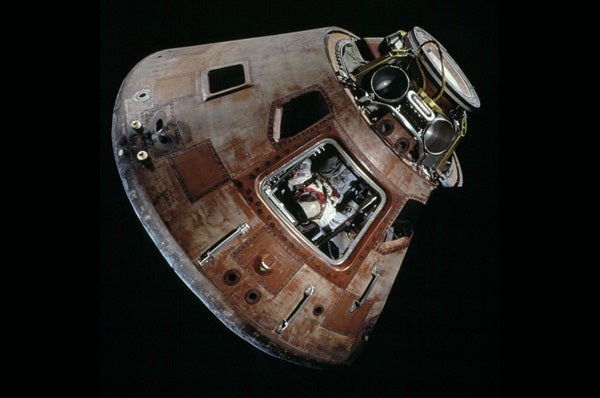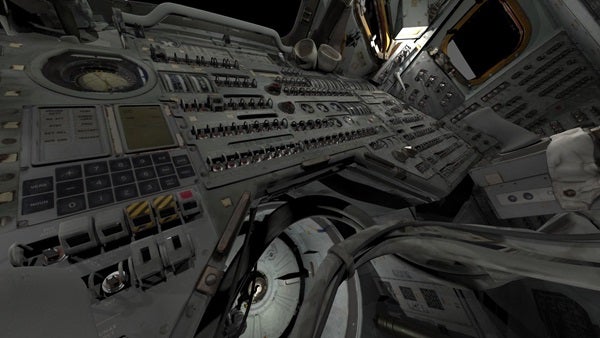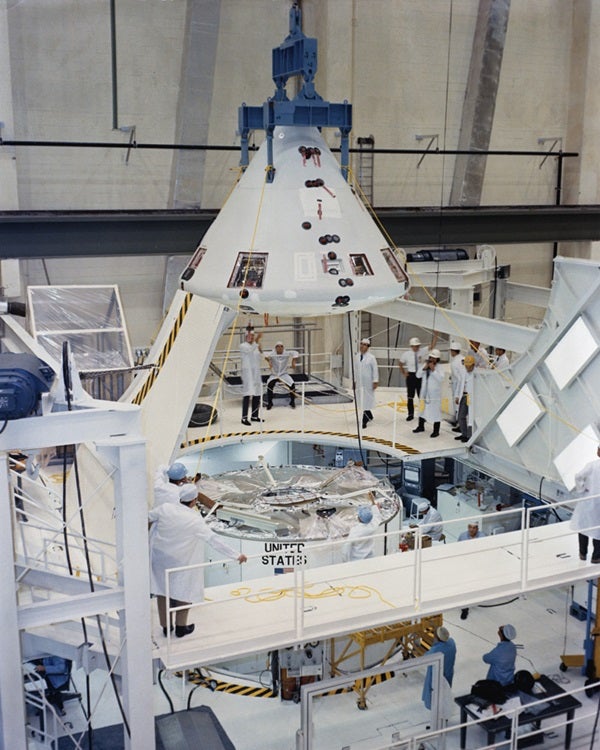On May 25, 1961, President John F. Kennedy stood before a joint session of Congress and challenged America to land a man on the Moon by the end of the decade. “No single space project in this period will be more impressive to mankind, or more important for the long-range exploration of space; and none will be so difficult or expensive to accomplish,” he said.
His words kicked off arguably the greatest engineering feat in modern history. The Apollo Command/Service Module (CSM) was conceived as the mothership — the spacecraft that would keep the crew alive throughout the lunar mission all the way to splashdown. The problem was no one knew exactly what that mothership would look like or need to do.
Taking experience from the one-man Mercury program into consideration — NASA had just one suborbital Mercury mission under its belt when Kennedy promised America the Moon — the space agency determined that the Command Module would be a truncated cone with a blunt, rounded bottom. The design was equal parts simplicity and necessity: It was easier to replicate an existing design than start from scratch, and the blunt end protected the crew from the heat generated during atmospheric reentry. It was coupled to the cylindrical Service Module, which carried the consumables (water, oxygen, power) the astronauts needed in space. Only the Command Module would carry the astronauts through reentry; the Service Module would be jettisoned beforehand.
NASA released its first call for proposals July 28, 1961. Interested aerospace companies were asked to present their bids for a three-man spacecraft that could keep astronauts alive in a shirtsleeve environment (i.e., no spacesuit required) for two weeks, with an additional two days of emergency life support in case of an off-target landing. What NASA didn’t ask for at this time was the landing payload; contractors were left to assume that some additional landing stage would turn their cone-shaped mothership into the landing ship. On October 11, 1961, NASA was presented with five bids: three from groups of contractors and two from single companies, one of which was North American Aviation.
North American was the underdog in this race. A month earlier, it had won the bid to build the second stage of the Saturn V rocket, and no one thought it could possibly win a second major piece of Apollo. When NASA reviewed the bids, North American scored second, behind the Martin Company. But North American had unique experience: Not only had it built exceptional planes like the P-51 Mustang and the B-25 bomber, it also had built the rocket-powered X-15 that was breaking speed and altitude records flying to the fringes of space. North American ultimately knew more about the technical and physical stresses of spaceflight than the other contractors, and so it won the contract.
Not one, but two
As North American began building the Command Service Module in early 1962, NASA began considering a new mission mode: Lunar Orbit Rendezvous. This mode kept the CSM and its heavy load of fuel for the return flight in orbit around the Moon, while a dedicated landing vehicle descended to the Moon’s surface. Though the rendezvous made the mission more complicated, it also made the payload lighter, because the lander could be smaller and thus require less fuel to escape the Moon’s gravity. The whole payload would be light enough to launch on a single Saturn V rocket, which was simpler to develop and gave NASA the best chance at meeting Kennedy’s end-of-decade deadline. To the surprise of many within the agency, Lunar Orbit Rendezvous quickly became the favored approach; NASA committed to it July 11.
Suddenly, North American had not only lost the glory of their module landing on the Moon, but the company was also now responsible for modifying its spacecraft to enable docking with the second ship and giving the astronauts some means to travel between the vehicles while they were connected. The required changes were significant; it was almost like building a whole new spacecraft. In an effort to retain its first year of work, North American came up with the “Block” concept. The original spacecraft, which couldn’t support a mission in conjunction with the Lunar Module, was called Block I. The Block II CSM would be designed to support a lunar mission.
The first Block I mission was scheduled as Apollo 1 in early 1967. Owing in large part to the amount of flammable material in the cabin, the pure oxygen environment under high pressure, and the heavy, inward-opening, three-part hatch, when a fire broke out during a routine pre-launch test, the crew had no chance of escape. Virgil “Gus” Grissom, Roger Chaffee, and Ed White were killed on the launchpad January 27, 1967, and for a moment, it looked like the Apollo program might not recover.
The subsequent accident investigation forced NASA to eliminate all Block I manned missions. Block I CSMs flew only on unmanned missions, in some cases with elements of the Block II version added to test them in advance of manned flights. Block II underwent several design changes following the tragedy. Now boasting a safer mixed gas environment on the launchpad as well as a different layout of material inside the spacecraft and a simpler two-part hatch, it made its first flight with Apollo 7 in October 1968.
From that point on, the CSM successfully flew on 10 Apollo missions, six of which landed on the Moon, bringing every astronaut home safely and serving as their home away from home en route to the Moon and back.












